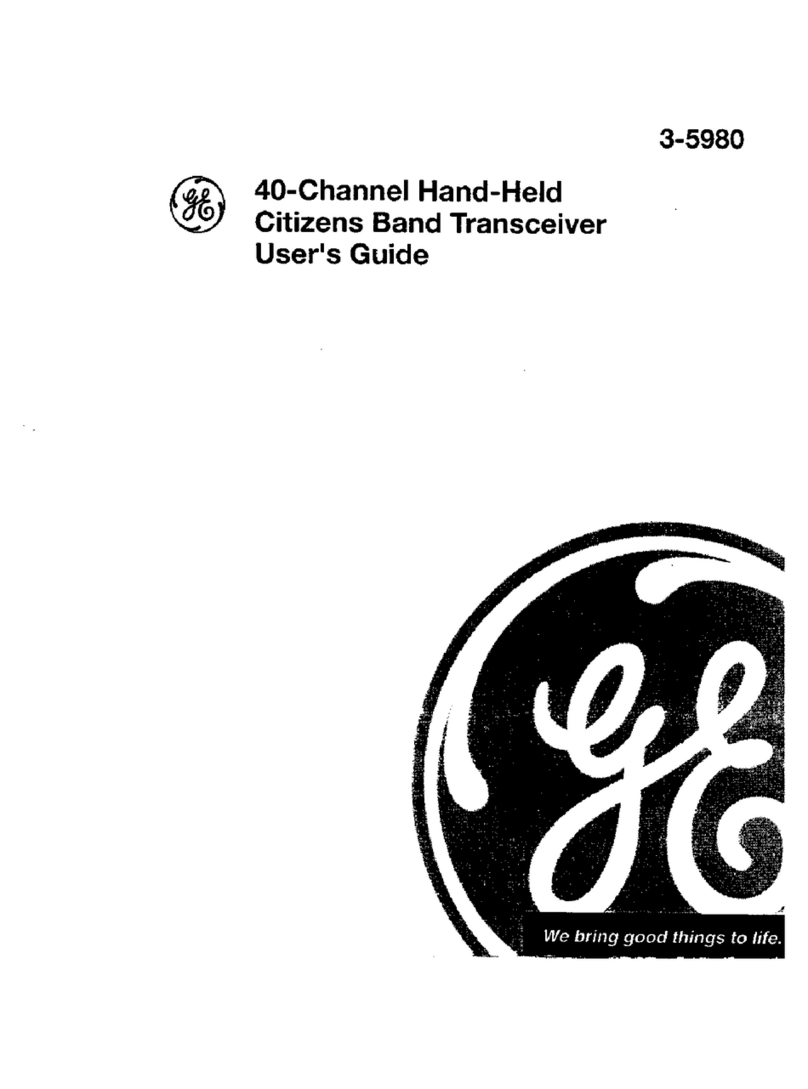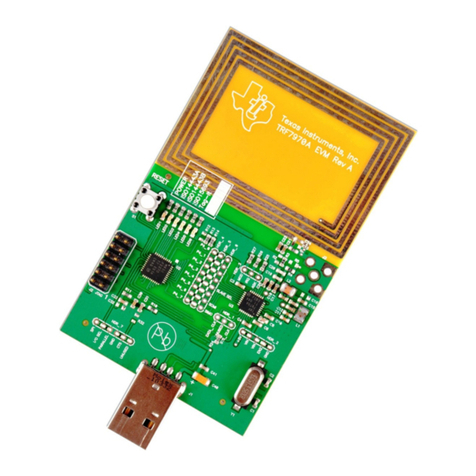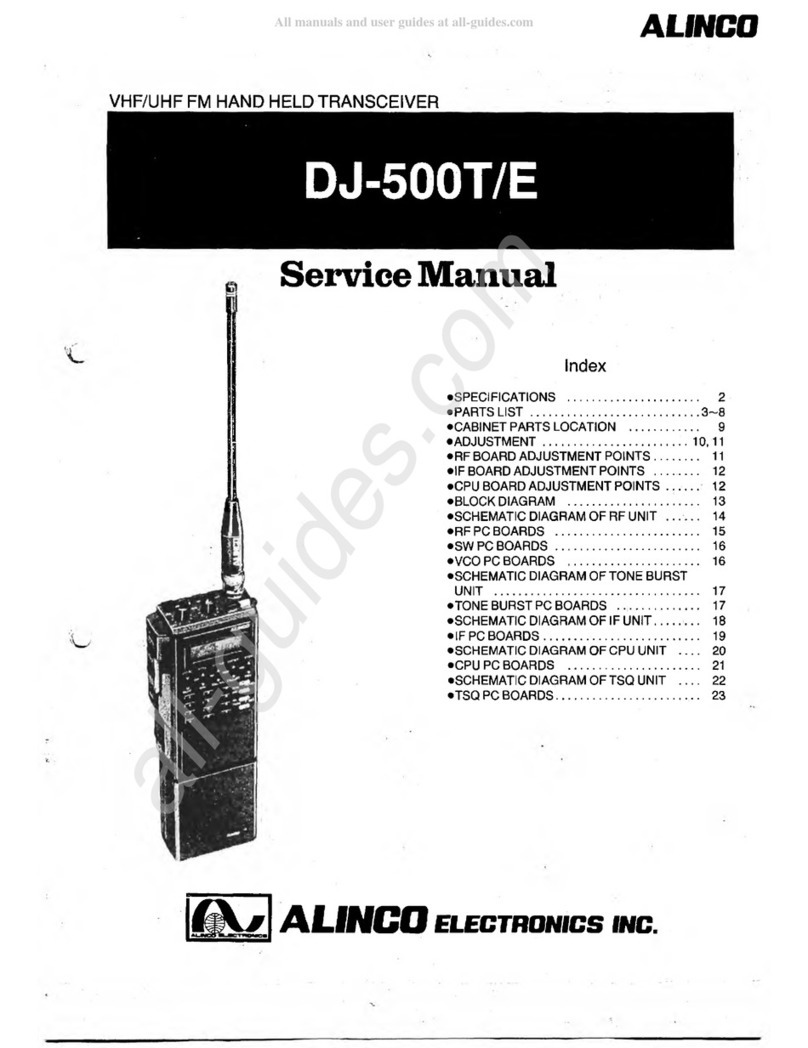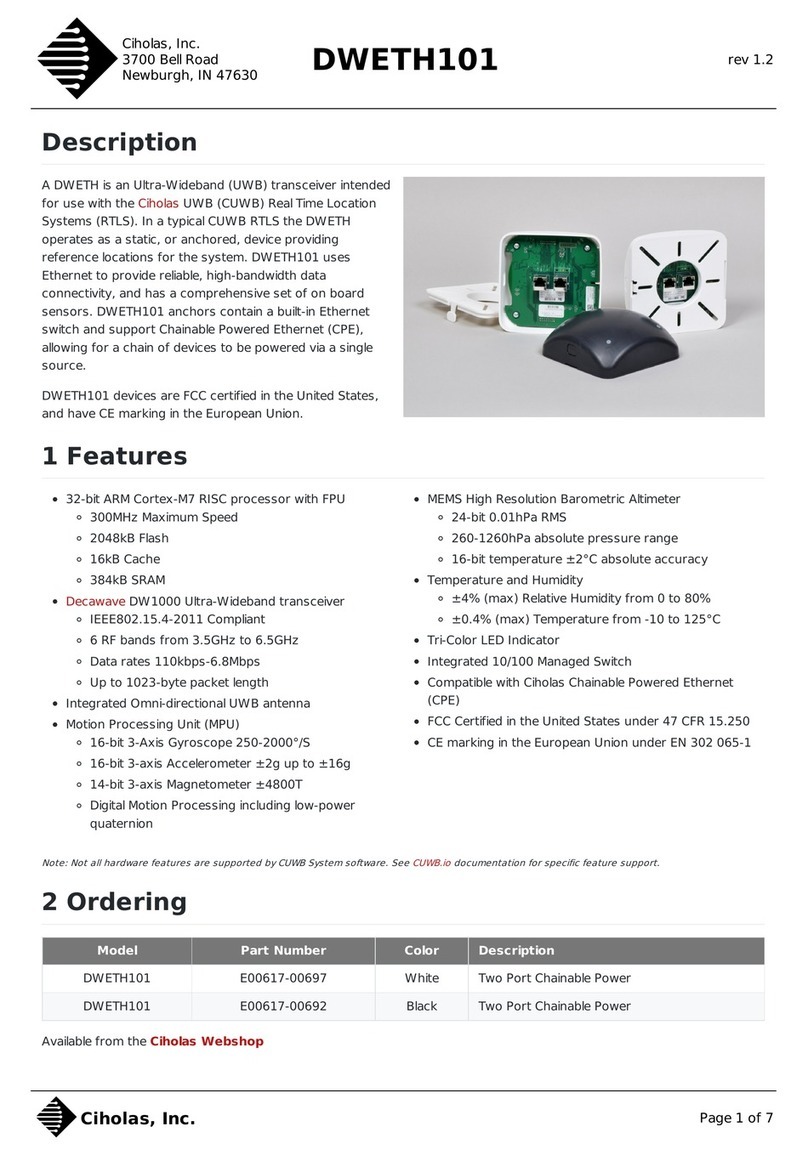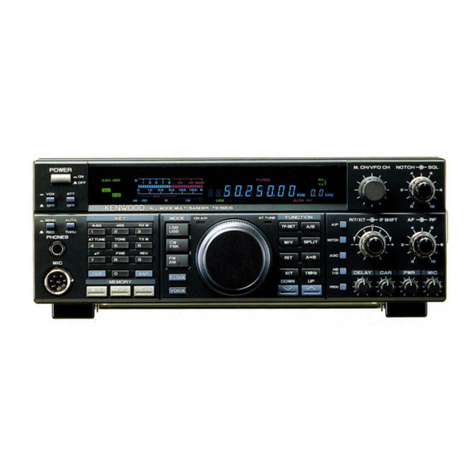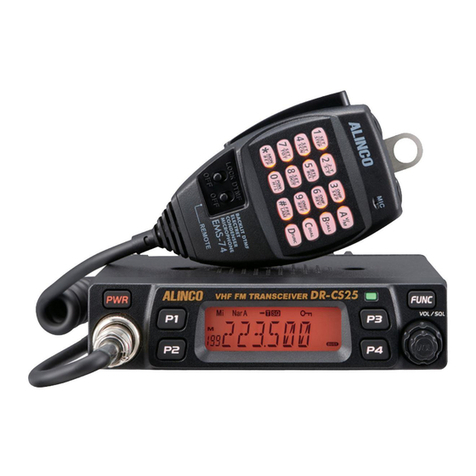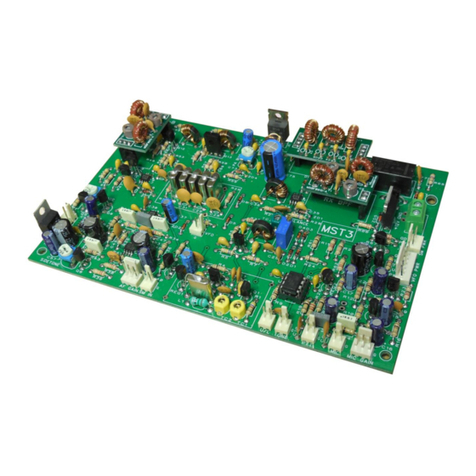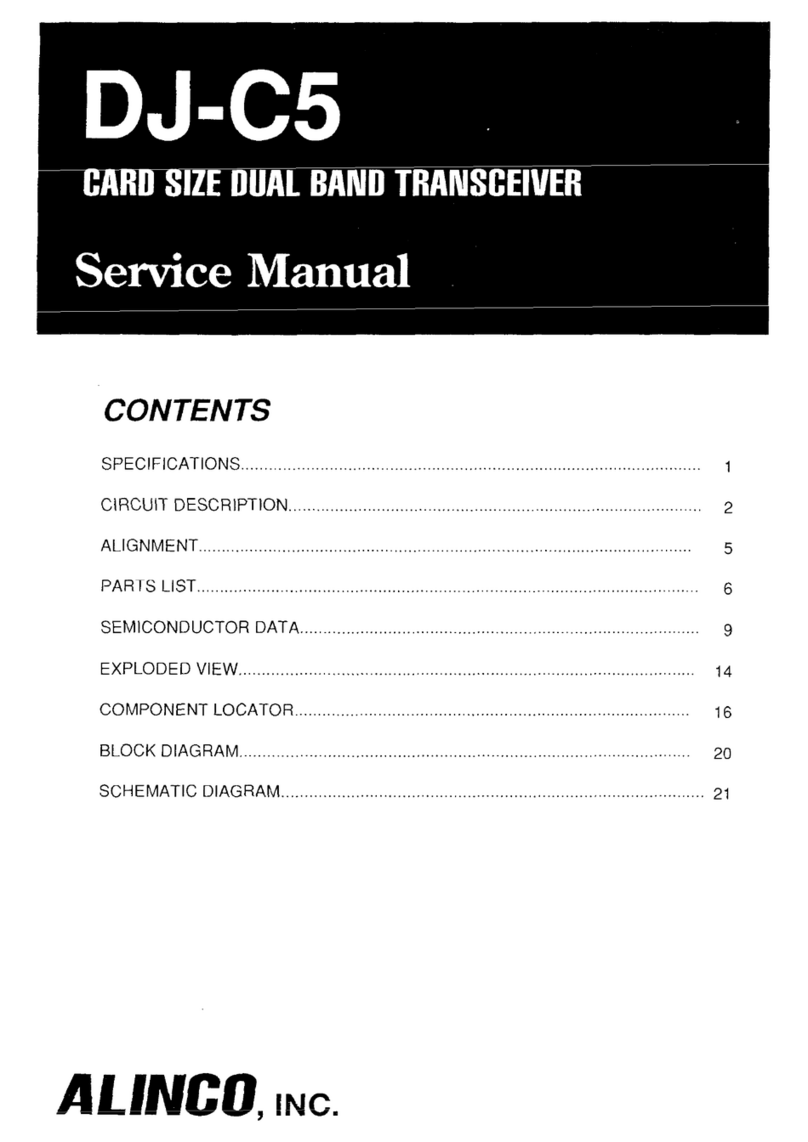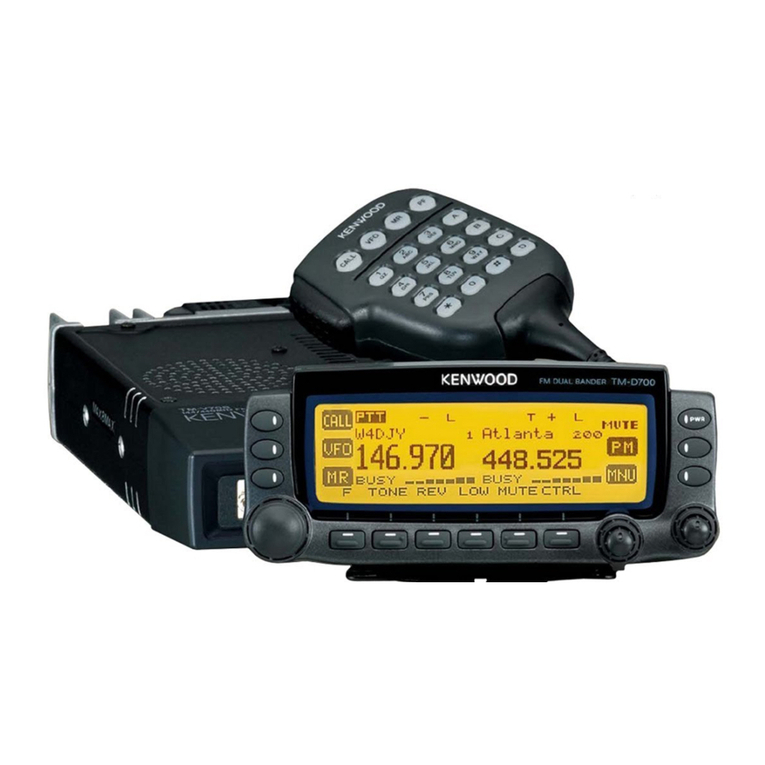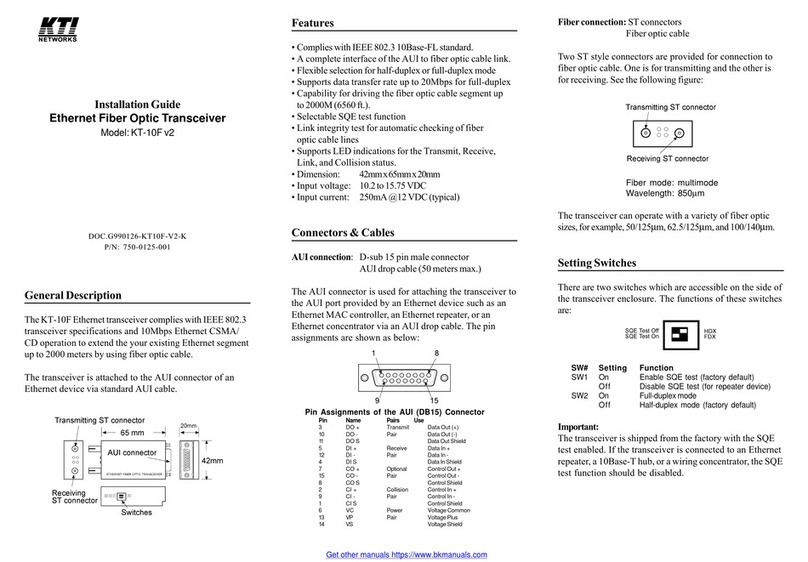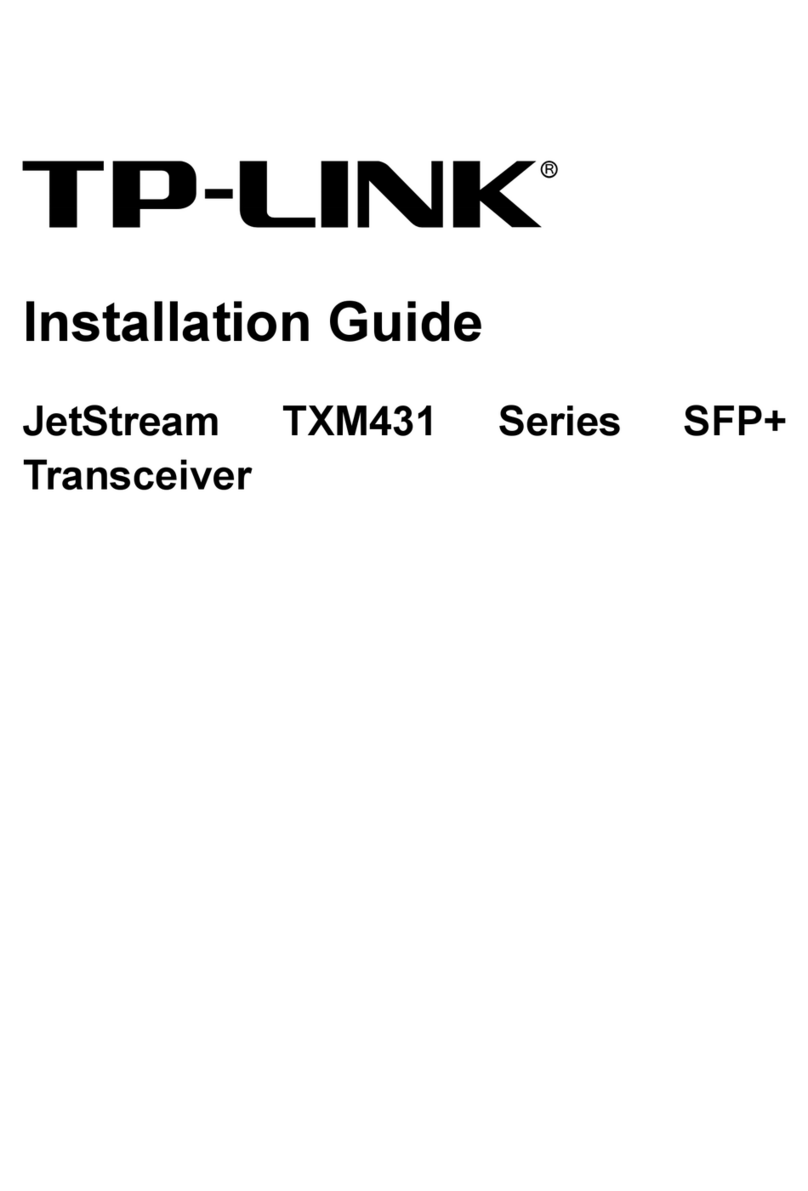Kongsberg SIMRAD IS15 Expander User manual

IS15 Instruments
General Manual
ALWAYS AT THE FOREFRONT OF TECHNOLOGY
MANUAL

This page is intentionally left blank

IS15 General Manual
20220760I 1
This manual is intended as a reference guide for operating and
correctly installing a Simrad IS15 Instrument System using the
digital IS15 Combi and IS15 Multi instruments, the analog IS15
Compass instrument and the IS15 Transceiver with speed and
depth transducers.
Please take time to read the manual to get a thorough
understanding of the operation and system components and their
relationship to a complete IS15 instrument system.
Other documentation material that is provided with your system
includes a ‘bridge card’, and a warranty card. The warranty card
must be filled out by the authorized dealer that performed the
installation and mailed in to activate the warranty. You will find
the warranty card in this manual.

IS15 General Manual
220220760I
Document revisions
Rev Date Written by Checked by Approved by
A 131299 NG GK ThH
B 180100 NG ThH
C 110200 NG IK ThH
D 100300 NG ThH
E 021100 NG ThH
F 181200 NG ThH
G 300301 NG ThH
H 290801 NG ThH
I 180402
Document history
Rev. A First edition
Rev. B More NMEA connections added. Missing information on Wind Speed
Damping and True Wind Speed Alarm implemented. Minor corrections in
text and editing. Addendum implemented.
Rev. C New addendum on this page.
Rev. D Addendum from rev. C implemented. Roblink Power Cable and IS15
Power Supply included. Chapter 6.9 added on IS15 as NMEA repeaters.
Technical specifications for IS15 Compass included.
Rev. E Limited edition. Fault Finding, Maintenance and Spare Parts List included.
Updated to software version V1R3. Mounting guidelines for transducers
added.
Rev. F Minor changes in text. Chapter 5.3 Instrument Software Information
added. More information on Roblink Test displays added in chapter 8.
Rev. G Instrument Software Information on page 48 updated. Figure 6-5
corrected. Depth specifications on page 45 updated.
Rev. H IS15 Expander included
Rev. I Updated to software version V1R5.

IS15 General Manual
20220760I 3
Contents
1 INTRODUCTION............................................................................................5
1.1 The Basic IS15 System..............................................................................5
1.2 Equipment supplied...................................................................................6
2 OPERATION OF THE IS15 COMBI INSTRUMENT................................9
2.1 General Description...................................................................................9
2.2 Powering Up..............................................................................................9
2.3 Display backlighting..................................................................................9
2.4 Display Screens.......................................................................................10
2.5 Screen Group 1: Depth, Speed, Trip Log................................................13
2.6 Screen Group 2: Wind.............................................................................17
2.7 Screen Group 3: VMG ............................................................................19
2.8 Screen Group 4: Nav(igation) .................................................................20
2.9 Screen Group 5: Time Log......................................................................23
2.10 Alarm Sounding.......................................................................................27
3 OPERATION OF IS15 MULTI INSTRUMENT .......................................29
3.1 General Description.................................................................................29
3.2 Powering Up............................................................................................29
3.3 Display backlighting................................................................................29
3.4 Display Screens.......................................................................................30
3.5 Screen Group 1: Depth............................................................................33
3.6 Screen Group 2: Speed............................................................................35
3.7 Screen Group 3: Wind.............................................................................37
3.8 Screen Group 4: Nav 1............................................................................39
3.9 Screen Group 5: Nav 2............................................................................40
3.10 Screen Group 6: Race..............................................................................42
3.11 Screen Group 7: Log ...............................................................................43
3.12 Alarm Sounding.......................................................................................44
4 OPERATION OF IS15 COMPASS INSTRUMENT .................................45
4.1 General Description.................................................................................45
4.2 Powering Up............................................................................................46
4.3 Display backlighting................................................................................46
4.4 The Heading Display...............................................................................46
4.5 Alarm Sounding.......................................................................................48
5 TECHNICAL SPECIFICATIONS...............................................................49
5.1 IS15 Combi and IS15 Multi ....................................................................49
5.2 IS15 Compass..........................................................................................52
5.3 IS15 Transceiver......................................................................................52
5.4 IS15 Expander.........................................................................................53

IS15 General Manual
420220760I
5.5 Instrument Software Information............................................................54
5.6 Display head and Transceiver dimensions..............................................57
5.7 Transducer dimensions............................................................................58
6 INSTALLATION...........................................................................................61
6.1 General ....................................................................................................61
6.2 Mounting of Instrument Head.................................................................61
6.3 System layout ..........................................................................................63
6.4 IS15 Transceiver Mounting.....................................................................64
6.5 Transducers..............................................................................................65
6.6 Cabling ....................................................................................................66
6.7 Instrument head connections...................................................................68
6.8 NMEA connections.................................................................................69
6.9 IS15 Transceiver......................................................................................73
6.10 IS15 Instruments as NMEA repeaters.....................................................75
6.11 IS15 Expander.........................................................................................79
7 SETTING-UP .................................................................................................89
7.1 First time turn on.....................................................................................89
7.2 Installation and Calibration Menu...........................................................90
7.3 General Screen Group .............................................................................92
7.4 Depth Screen Group................................................................................94
7.5 Boat Speed Screen Group........................................................................95
7.6 Temperature Screen Group .....................................................................97
7.7 Wind Screen Group.................................................................................97
7.8 Navigation Screen Group........................................................................98
7.9 Compass Screen Group ...........................................................................98
7.10 Rudder Screen Group............................................................................100
7.11 Expander Screen Group.........................................................................100
7.12 Leaving the Installation Menu...............................................................101
7.13 Setting up the Compass Instrument.......................................................101
8 FAULT FINDING........................................................................................107
9 MAINTENANCE.........................................................................................117
9.1 General Maintenance.............................................................................117
9.2 Annual Maintenance..............................................................................117
9.3 Removal of Instruments ........................................................................117
9.4 Return for Service..................................................................................118
9.5 Local Master Reset................................................................................118
10SPARE PARTS LIST ..................................................................................119

Introduction
20220760I 5
1INTRODUCTION
1.1 The Basic IS15 System
A basic stand alone IS15 SDT-1 (tri-data) system is shown in
Figure 1-1. It comprises:
•IS15 Combi instrument head
•IS15 Transceiver
•Speed/temperature and Depth transducers.
More instrument heads may be added to the system by using
single cables in a “daisy chain”. Please study the different
system configurations in section 6 for more information.
Speed/temp
transducer Depth
transducer
Supply 10,8-15,6VDC
SIMRAD
IS15 Combi
10 m (33') 10 m (33')
10 m (33')
IS15
Transceiver
SIMRAD
0,3 m (1')
NMEA inpu
t
or output
Circuit breaker
Fuse 5A
Figure 1-1 - IS15 SDT-1 System Layout

IS15 General Manual
620220760I
The IS15 Instrument System uses a single cable to carry power
and data between the IS15 Transceiver and the instruments. The
transfer of power and data is made by a proprietary data link
called Roblink. Interface to peripheral equipment is made on
NMEA 0183 format, the marine industry standard.
1.2 Equipment supplied
The units in an IS15 Instrument system are supplied with the
following parts as standard:
•All instrument heads: Mounting kit, 0,3 m (1’) IS15
(Roblink) Cable and Operator’s
Quick Reference Guide (“bridge
card”).
•IS15 Transceiver: Mounting kit, 10 m (33’) IS15
(Roblink) Cable and IS15 General
Manual.
•Speed/Temperature
transducer: 10 m (33’) cable attached
+ mounting instructions.
•Depth transducers: 10 m (33’) cable attached +
mounting instructions.
Optional equipment
•IS15 Cable 2 m (6,5’) P/N 22093728
•IS15 Cable 5 m (16’) P/N 22092548
•IS15 Cable 10 m (33’) P/N 22092027
The cables can be used for extension and/or as cables for
NMEA interface to peripheral equipment.
•IS15 Cable Adapter (joiner) P/N 22092001
Interconnects IS15 cables where cable extension is required.
•IS15 Roblink Power Cable 2,5 m (8’) P/N 22093587.
Required when using 2 or 3 instrument heads as NMEA
repeaters in a “daisy chain”.
Also required when using a single IS15 Wind instrument as
stand alone with the Wind Transducer connected directly to
the head. Comes as standard with a W-1 system.
•IS15 Power Supply P/N 22093595.
Required when using 4-7 instrument heads as NMEA
repeaters in a “daisy chain”.

Introduction
20220760I 7
•IS15 Expander (P/N 22092431)
IS15 Expander is an upgraded version of the IS15
Transceiver.
In addition to electronics for depth sounding and speed/
temperature transducers it offers two NMEA I/O ports and the
capability of driving 8 instrument heads. Further instructions
on how to connect the instruments and peripheral equipment
are found in this manual.
The following parts are included as standard:
−Mounting kit
−2 ea. 10 m (33’) Roblink cable
−IS15 General Manual

IS15 General Manual
820220760I
This page is intentionally left blank

Operation of IS15 Combi
20220760I 9
2OPERATION OF THE IS15 COMBI INSTRUMENT
2.1 General Description
The instrument is operated by five buttons. By pressing one of
the arrow buttons you can move up, down, or sideways through
the selection of display screens that are available. The table of
screens is shown on page 11. The reset button is only active on
some of the screens. When a button is pressed a beep will
confirm the operation.
The display is divided into three sections, each section normally
containing one set of information. On some screens a graphical
display may cover more than one section.
2.2 Powering Up
When the instruments are powered up for the first time, see
section 7.1. ‘First time turn on’ on page 89.
At normal power up, each instrument shows the start-up screen
with the software version for approximately two seconds. The
display will then change to show the screen that was on at turn-
off.
2.3 Display backlighting
Press the button and hold for 2 seconds. The display then
presents the backlighting level. Repeat pressing until desired
backlighting level. Selectable values are 1-7 and off (0).
LCD
Display
Screen group
reverse button Screen group
advance button
Screen reverse
button
Screen advance
button/illumination
control
Reset button
Upper screen
section
Lower screen
section
Middle screen
section

IS15 General Manual
10 20220760I
2.4 Display Screens
The Table of Display Screens
The display screens of the COMBI instrument are arranged in a
‘table’ as per below. The table consists of a number of screen
groups, each group being a logical collection of useful screens.
To access the screens you move ‘up’ or ‘down’ through the
groups using the upper and buttons, and ‘sideways’
through the screens using the lower and buttons. When
moving ‘up’ or ‘down’ to a new screen group the first display
will be the last one accessed in that group. If you press and hold
any of the two buttons it will return to the group’s
Main Display.

Operation of IS15 Combi
20220760I 11
Screen
Group
Screen 1 Screen 2 Screen 3 Screen 4 Screen 5 Screen 6 Screen 7
Group 1 Depth
Boat speed
Trip Log
*3
Depth
SOG
Sea Temp.
*2
Trim speed
Depth
*3
SOG
Boat speed
Average
speed
Max. speed
*1
Shallow
alarm status
Deep alarm
status
Anchor
alarm status
*5
Group 2 Apparent
Wind Angle
Apparent
Wind Speed
*1
True Wind
Angle
True Wind
Speed *3
Wind
Direction
*1
Group 3 VMG to
wind
Boat speed
Apparent
Wind Angle
*1
VMG to
wind
Trim speed
Apparent
Wind Angle
VMG to
wind
Apparent
Wind Speed
Apparent
Wind Angle
Group 4 Heading
Boat speed
Rudder
angle *1
Heading
COG
SOG
*1
Waypoint
ID
WP bearing
XTE
*1
Waypoint
ID
WP bearing
WP distance
*1
Waypoint
ID
WP bearing
COG
*1
VMG to
WP
Time to go
Local time
*1
Position
Group 5 Race time
Local time
*2
Race time
Race log
Local time
*2
Cum. log
Trip log
Passage
time
Figure 2-1 - Table of Display Screens
* Denotes the number of (concealed) sub-screens (-Setup-)
Notes ! 1. If data is not available then “----” will be displayed in place
of data on the appropriate screen(s).
2. Some of the main screens have (concealed) sub-screens
attached for added information and user settings.
Sub-screens (- setup -)
The diagram on the next page shows the sub-screen matrix, how
to select a sub-screen and how to change a setting.
Note ! Main screens that have repeated or no sub-screen(s) are not
shown in this diagram.

IS15 General Manual
12 20220760I
Select
timer
5-10 min.
3-6 min.
UTC
Offset
TIMER LOG
Select
timer
5-10 min.
3-6 min.
UTC
Offset
Mag. Var
Monitor
Auto or
manual
adjust
UTC
Offset
Mag. Var
Monitor
Auto or
manual
adjust
NAVIGATION
Mag. Var
Monitor
Auto or
manual
adjust
VMG
Boat Speed
Damp
0-3
Mag. Var
Monitor
Auto or
manual
adjust
WIND
Wind
damp.
1-4
True Wind
Speed
Alarm
ON/OFF
Wind alrm
limit
Shal. Alarm
ON-OFF
Shal. Alarm
Limit
Deep alarm
ON-OFF
Deep alarm
Limit
Anch. Alarm
ON-OFF
DEPTH/SPEED
Boat Speed
Damp
0-3
Depth
Sounder
ON/OFF
Depth damping
GROUP
1
2
3
4
5
Main screen - Setup -
Sub screen 2
2 sec.
- Setup -
Sub screen 1
XXX YYY YYY
2 sec. 2 sec.
Main screen
2 sec.
Enter setting
XXX - Setup -
Quick press to
select sub screen Quick press to
adjust setting Exit
Increase
Decrease
Figure 2-2 Access of sub-
screen(s)
SUB
SCREEN
MAIN
SCR.

Operation of IS15 Combi
20220760I 13
2.5 Screen Group 1: Depth, Speed, Trip Log
There are five screens in this group (all have one or more sub
screens).
Screen 1
DEPTH
BOAT SPEED
TRIP LOG
•The upper screen section displays ‘DEPTH’, unit (e.g. ‘mtrs’)
and the depth value. An arrow indicates a rising (↑) or falling
(↓) bottom. A bargraph indicates the strength of the signal.
‘EXT’ replaces the bargraph if the depth signal is from an
external source on NMEA format.
•The middle screen section displays ‘BOAT’, unit (e.g. ‘kts’)
and boat speed value.
•The lower screen section displays ‘TRIP’ and the trip log
value in nautical miles.
Note ! If the system depth transducer signal is lost, the Depth display
will flash the last good echo value for one minute, then it will
show ---. If there is an alternative depth input to the system on
NMEA format and the sounder is set to Off, this depth will be
displayed instead.
Screen 1 has three sub screens. Setting of the boat (water) speed
damping, switching the depth sounder on and off, and setting the
level of depth damping.
Speed damping
The displayed speed has four damping levels (0-3), 0=Off.
On power up the last set damping level is selected.
To change the speed damping level follow the procedure in
Figure 2-2, page 12 and select the wanted damping level. The
higher the figure the more damping.
To Set the Depth Sounder On or Off
In certain circumstances, e.g., to save power in known waters or
when out of depth range, you may want to turn the depth sounder
off. It is also recommended to turn it off if there is another
sounder on board operating on the same (200 kHz) frequency.
Interference between the two can thus be avoided.

IS15 General Manual
14 20220760I
Note ! When the sounder is turned off, the display will show OFF
instead of the depth reading.
Follow the instructions in Figure 2-2 to access the depth sounder
ON/OFF screen. With the ON-screen flashing select OFF and
return to Screen 1 as per instructions.
This setting is not affected by power off/on or a Communication
Reset, but defaults to ON after a Master Reset.
Depth damping
The displayed depth has four levels (0-3), 0 = Off. On power up
the last set damping is selected. To change the depth damping
level follow the procedure in Figure 2-2, page 12 and select the
wanted damping level.
The higher the figure the more damping.
Screen 2
DEPTH
SPEED OVER GROUND
SEA TEMPERATURE
•The upper screen section displays ‘DEPTH’, as on Screen 1.
•The middle screen section displays ‘SOG’, the unit (e.g.
‘kts’) and the Speed Over Ground value. SOG will only be
displayed if a GPS receiver input is available.
•The lower screen section displays ‘SEA’, the sea temperature
value and the units, ‘°C’ or ‘°F’.
Screen 2 has two sub-screens: one for setting the depth sounder
on and off and one for depth damping. Refer to above.
Screen 3
TRIM SPEED
DEPTH
•The upper screen section displays ‘TRIM’ and the unit, e.g.
‘kts’. The Trim Speed is the difference between the present
boat speed and the target speed.
•At turn on the Trim Speed will only be indicated if it has
been reset (see below), until that time it will show ‘----’.
•The lower screen section displays DEPTH as on screens 1
and 2.

Operation of IS15 Combi
20220760I 15
Screen 3 has three sub-screens, similar to screen 1. Refer to
pages 13 and 14.
To Reset the Trim Speed
The Trim Speed may be reset at any time, as per below:
•Select either of the two display screens that show Trim
Speed.
•A short press of the (Reset) button will set the target
speed as the current speed. The trim speed displays will then
show changes from the current speed.
Screen 4
SPEED OVER GROUND
BOAT SPEED
BOAT AVERAGE SPEED
BOAT MAX SPEED
•The upper screen section displays ‘SOG’, the unit (e.g. ‘kts’)
and the Speed Over Ground value. SOG will only be
displayed if a GPS receiver input is available.
•The second screen section displays ‘BOAT’, speed value and
the unit (e.g. ‘kts’).
•The third screen section displays ‘AVG’, average speed value
and the unit (e.g. ‘kts’). The average speed is calculated as
the distance covered by the boat since power up or when the
passage time was last reset, divided by the passage time.
•The lower screen section displays ‘MAX’, maximum speed
value and the unit (e.g. ‘kts’).
Screen 4 has a sub-screen for setting the water speed damping.
Note ! Average speed and max speed are reset by Passage Time reset
(See paragraph 2.9).

IS15 General Manual
16 20220760I
Screen 5
SHALLOW ALARM
DEEP ALARM
ANCHOR ALARM
The screen shows the setting of the alarm limits and whether the
alarms are activated or not (On/Off).
The alarms can be set to ON or OFF at any time.
Screen 5 has five sub screens. The first two are for Shallow
Alarm ON/OFF and Shallow Alarm Limit settings. The next two
are for Deep Alarm ON/OFF and Deep Alarm Limit settings.
The last one is for setting the anchor alarm ‘ON’ or ‘OFF’.
SHALLOW ALARM AND DEEP ALARM
The screen displays the Alarm status, ‘ON’ or ‘OFF’, and the set
alarm limit in the order shown.
To turn the alarms ON or OFF and/or set the alarm limits follow
the procedure as shown in Figure 2-2, page 12.
ANCHOR ALARM ON/OFF
Refer to Figure 2-2, page 12 to turn the Anchor Alarm ON or
OFF.
Note ! The anchor alarm should be off when the boat is not at anchor.
The alarm will sound when during a 40 seconds time period
there is a change in the depth of 2-3 meters (6-10 ft.).

Operation of IS15 Combi
20220760I 17
2.6 Screen Group 2: Wind
There are three screens in this group.
Screen 1
APPARENT WIND ANGLE
APPARENT WIND SPEED
•The upper screen section displays ‘APPARENT WIND’
•The middle screen section displays a wind direction icon and
the apparent wind angle value.
•The lower screen section displays the apparent wind speed
reading and the unit (e.g. ‘kts’).
Screen 1 has a sub screen for setting the wind data damping.
Wind damping
The displayed wind information has four damping levels (1-4).
On power up the last set damping level is selected.
To change the damping level follow the procedure in Figure 2-2,
page 12 and select the wanted damping level. The higher the
figure the more damping.
Screen 2
TRUE WIND ANGLE
TRUE WIND SPEED
•The upper screen section displays ‘TRUE WIND’.
•The middle screen section displays a wind direction icon and
the True Wind Angle value.
•The lower screen section displays the True Wind Speed
reading and the unit (e.g. ‘kts’).
Screen 2 has three sub-screens. One for setting the wind
damping, one for switching the wind speed alarm on and off, and
one for setting the wind speed alarm limit.
Wind damping
Refer to screen 1.
True Wind Speed Alarm ON/OFF
Refer to Figure 2-2, page 12 to turn the True Wind Speed Alarm
ON or OFF.

IS15 General Manual
18 20220760I
True Wind Speed Alarm limit
Refer to Figure 2-2, page 12 to set the wind speed alarm limit (0-
99 knots).
Screen 3
WIND DIRECTION
The screen displays the Wind Direction in degrees and the unit
(‘T’rue or ‘M’agnetic). Refer to page 20.
Screen 3 has a sub screen for setting the magnetic variation.
Refer to page 21.
Notes ! 1. The Wind Direction is calculated from available heading
data. The wind direction given is the effective wind direction
over the water. The display will be most accurate after a
period on one heading, however, it will respond rapidly to
course changes.
2. If there is no heading data, but Course Over Ground (COG)
data is available then the Wind Direction is calculated from
the Course Over Ground. In this case there is compensation
for the tide, and the wind direction given is the effective wind
direction over the ground. However the display will not be
accurate after a course change, and will require a period on
one heading before it is correct. (Any errors in the
Navigation Receiver’s fix will degrade the accuracy of the
wind direction.)
3. The Wind Direction is referenced to either Magnetic or True
North as selected for the heading. The data can be converted
from one to the other if the local magnetic variation is
available (page 20).
4. Note that the ‘TRUE’ and ‘APPARENT’ readings that are
shown in this group of screens relate to the Wind Speed and
Angle, and not the Wind Direction.
Other manuals for SIMRAD IS15 Expander
4
Table of contents
Other Kongsberg Transceiver manuals

Kongsberg
Kongsberg SIMRAD IS15 Expander User manual
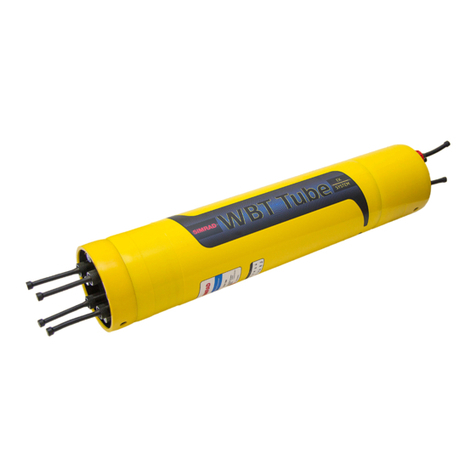
Kongsberg
Kongsberg SIMRAD WBT TUBE User manual

Kongsberg
Kongsberg cPAP30 User manual
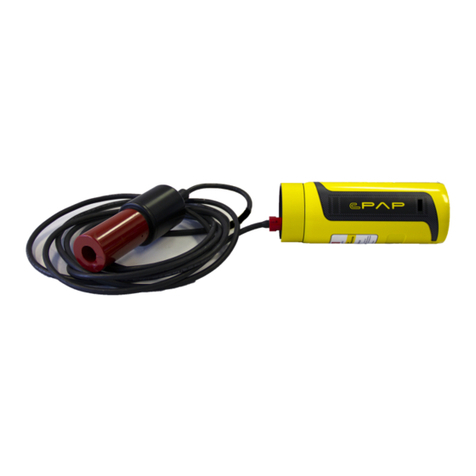
Kongsberg
Kongsberg cPAP MKII User manual

Kongsberg
Kongsberg SIMRAD WBT MINI User manual
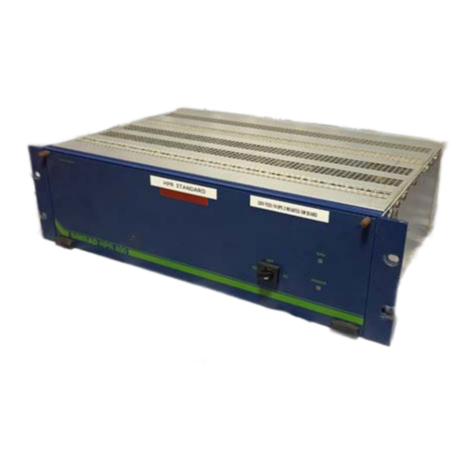
Kongsberg
Kongsberg HPR 400 User manual
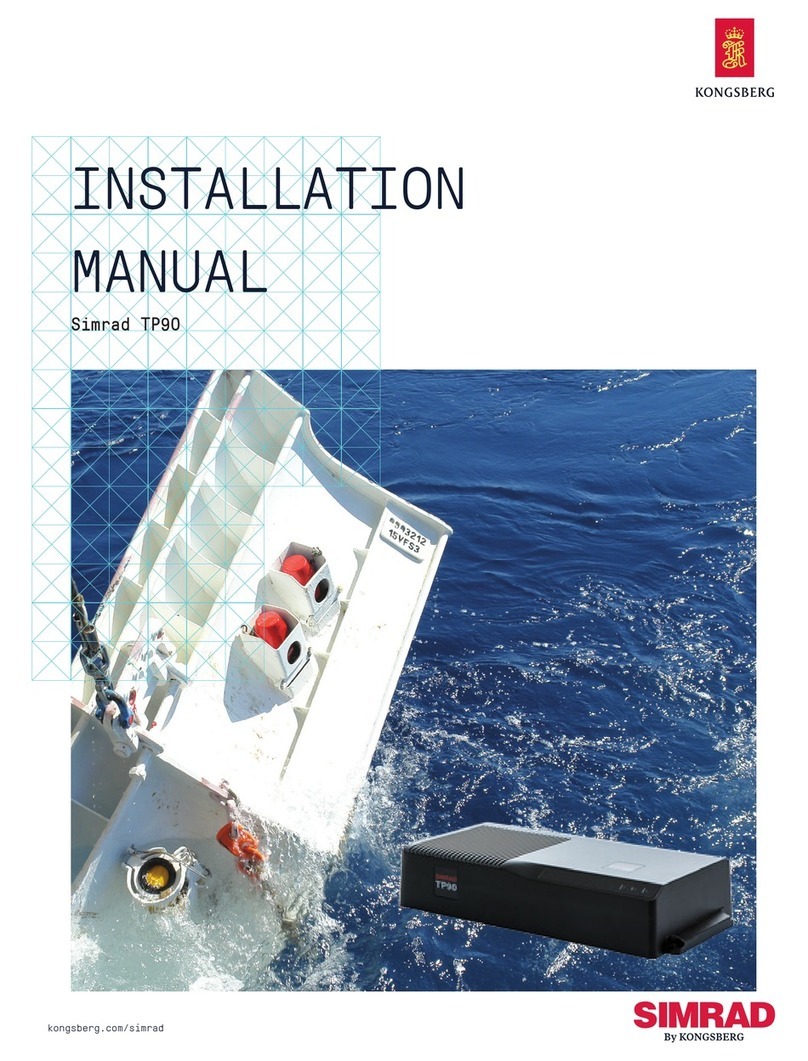
Kongsberg
Kongsberg SIMRAD TP90 User manual

Kongsberg
Kongsberg Simrad RS86 User manual
